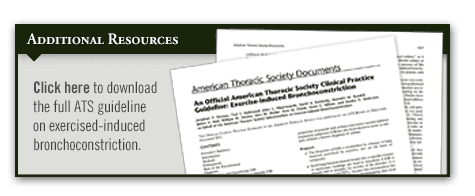Exercise-induced bronchoconstriction (EIB) describes the acute airway narrowing that occurs as a result of exercise. The condition occurs in a substantial number of patients with asthma but may also present in those without known asthma. According to current estimates, EIB may affect about 15% to 20% of patients without diagnosed asthma. For Olympic and elite athletes, the prevalence estimates are even higher, ranging between 30% and 70%. Given its high prevalence, evidence-based guidelines for EIB management are of critical importance.
In the American Journal of Respiratory & Critical Care Medicine, the American Thoracic Society (ATS) published a clinical practice guideline to help clinicians manage patients with EIB. To develop the guidelines, a multidisciplinary panel of stakeholders was convened to review the pathogenesis of EIB. Recommendations were established for the diagnosis and management of EIB as well as its environmental triggers. The document also contains special considerations for managing elite athletes.
Diagnosis & Treatment of Exercise-Induced Bronchoconstriction
To diagnose EIB, the ATS recommends that clinicians focus their attention on exercise-induced changes in lung function rather than symptoms. Serial measurements of FEV1 after a specific exercise or hyperpnea challenge are preferred. A drop in FEV1 of at least 10% defines EIB.
Several effective treatments and preventive measures, both pharmacologic and non-pharmacologic, are available for EIB. It’s strongly recommended that all patients with EIB use an inhaled short-acting β2-agonist about 15 minutes before exercise. For those with persistent symptoms or who use short-acting β2-agonist therapy daily or more frequently, the guidelines strongly recommend using a daily inhaled corticosteroid, a daily leukotriene receptor antagonist, or a mast cell–stabilizing agent before exercise.
The guidelines note, however, that β2-agonists and some other drugs used to treat EIB are considered performance enhancers and are therefore banned or restricted in athletic competitions without formal documentation of medical necessity. This doesn’t mean that these patients should stop competing. Clinicians should try to tailor treatments to the guidelines of the governing bodies of these sports. For example, patients can
be instructed to do interval or combination warm-up exercises before planned exercise.
It may take a few weeks after starting daily inhaled corticosteroids to see maximal improvement. The ATS guidelines strongly recommend against using inhaled corticosteroids only before exercise. Daily use of an inhaled long-acting β2-agonist as
monotherapy is not recommended because of the potential for serious adverse effects.
Future Revisions & Updates to ATS Guidelines
It’s anticipated that future revisions and updates to the ATS guidelines will be developed as new clinical research data emerges. In the meantime, the current recommendations synthesize the latest clinical evidence and can help guide the care of EIB in patients with or without asthma and in athletes at all levels of competition.




 admin
admin